|



Help keep
FORDification.com
banner-free!
|

|
|
|
Identifying 1967-1972 Ford Pickups |
| Page 1 |
Page 2 | |
|
 |
|
Since Ford didn't make major changes between the various years of this era of
pickups, sometimes identification can be a problem...especially when a previous
owner has made any modifications or repairs. Use this guide to help you
determine the correct year of manufacture of your pickup and accessories. |

|
Grilles (and other trim level
basics) |
|
See
Body Trim and Insignias for more detailed
information on grilles and headlight trim.
See 1967 Ford Trucks Model Year Differences
for features exclusive to '67 trucks. |
|
1967
 The new '67 F-series
trucks were redesigned to a squared-off look with the headlights worked
into the rectangular grille. The parking lamps were located under the
headlights. The interior increased in size and had more glass. Three trim levels (base, Custom Cab and
Ranger) were offered. The Ranger had color-keyed carpeting and door panels
and plusher seats (in a cab that was 3 inches wider inside than it's
predecessor) and chrome
exterior trim (such as the grille) standard. Other improvements of the '67
model included larger tires, a bigger clutch and a heavier, stronger frame
permitting increased carrying capacity. The new '67 F-series
trucks were redesigned to a squared-off look with the headlights worked
into the rectangular grille. The parking lamps were located under the
headlights. The interior increased in size and had more glass. Three trim levels (base, Custom Cab and
Ranger) were offered. The Ranger had color-keyed carpeting and door panels
and plusher seats (in a cab that was 3 inches wider inside than it's
predecessor) and chrome
exterior trim (such as the grille) standard. Other improvements of the '67
model included larger tires, a bigger clutch and a heavier, stronger frame
permitting increased carrying capacity.
|
|
 1968 1968
The grille got a
new look. To comply with Federal safety standards, reflectors were added
to the hood emblems and the rear of the bed. Inside, Ford improved the armrests, changed to
safety door releases and breakaway window cranks, and redesigned the heater controls.
(The grille
shown here is the optional Ranger version. The grille emblem was only used
in '68-'69) |
|
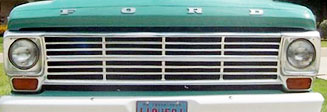 1969 1969
The grille was
the same as 1968 except that a groove was stamped on the center horizontal
bar. Corinthian White was used for the standard grille which changed
again midyear to anodized, and on Ranger models the groove in the aluminum
grille was painted red. The headlight surrounds were painted black in
the center and included the grille emblem, which was the last year this
grille emblem was used.
Starting in late-'69 a 302-c.i. V8 with 220 horsepower
was now offered, in addition to the former engine choices. |
|
1970
 The
grille again got a new look with a grid pattern. The parking lights were
wraparound and rear side markers were added. The trim packages changed
names - what was Standard became Custom and Custom Cab became Sport Custom. In addition to the Ranger, a new top of the line trim package was
offered, called the Ranger XLT. The
grille again got a new look with a grid pattern. The parking lights were
wraparound and rear side markers were added. The trim packages changed
names - what was Standard became Custom and Custom Cab became Sport Custom. In addition to the Ranger, a new top of the line trim package was
offered, called the Ranger XLT. |
|
 1971 1971
The grille
changed to six rectangular sections on each side of the center vertical
bar. The interior had a new two-spoke steering wheel with a horn bar
instead of the button. The F-100 hubcaps were passenger car style. |
|
 1972 1972
The grille
changed slightly to four rectangular sections on each side of the center
vertical bar. Engine and transmission choices stayed the same. Power
brakes were optional on 4-wheel drive trucks. |

|
Instrument Panels |

|
ABOVE: This is an example of standard
instrumentation for the 1967-1969 Ford and Mercury models and included a steel
surround (bezel). 1967 bezels were trimmed in white and
'68-'69 versions (shown here) were trimmed in silver.
UPPER RIGHT: Ford's full instrumentation package
also included gauges in the lower two pods instead of just
idiot lights and were standard on the Custom Cab and Ranger.
The chrome-plated plastic versions were offered from '67-'69
on the Custom Cab and Ranger as well as on all '70-'72 models.
LOWER RIGHT: The woodgrain cluster was introduced
in '69 on the Ranger and used a Teakwood style woodgrain. Burl
Walnut woodgrain was used for '70-'72 XLTs, which also
had lower woodgrain panels and a plastic woodgrain 'modesty'
panel below the RH side of the dash. The '70-'72 non-XLT
Ranger had no woodgrain accents. |
|
|
 
Note: '67-'70
speedometers had a red line above the 70MPH thru 100MPH markers (see top
photo). '71-'72 speedometers did not have this line. |
|

(A =
Wiring Harness Connection)
Pictured here
are the differences in the instrument panels. The '67-'69 panels had a stamped steel rear
gauge housing using individually-wired 1895 bulbs. The
'70-'72 versions had a printed circuit board and
removable 168/194 bulb sockets.
The early panel assemblies are not interchangeable with the later
assemblies, although all bezels are fully interchangeable.
|
This is a comparison shot of the back sides of two '67-'69
instrument panels. The top panel has warning (idiot) lights
while the bottom one has full instrumentation.
(Click the image at right to enlarge a comparison picture of
the two styles.) |
 |
Although the '70 circuit boards do have a printed circuit board like the
'71-'72 versions, the '70 circuit board is a one-year-only item...they are
slightly different from the '71-'72 versions. The '70 harness connector is
1-1/2" high whereas the '71-'72 connector is 2-1/4" high (for
the gauge version).
|
The '71-'72 panels have two styles...with idiot lights or
with full-instrumentation (gauges). The circuit boards are different between the
two, meaning that each style has it's own differently-sized
wiring harness connector. (The gauge-type harness connector
is larger than the idiot-light style.)
(Click the image at right to enlarge a comparison picture of
the two styles.) |
 |
You cannot
install a gauge-type panel in a truck originally equipped with idiot
lights (or vice versa) without installing a matching wiring
harness, because of differences in wiring for the
ammeter in the harness under the dash and hood. The gauge-type wiring harness
includes a shunt located between the alternator and the starter solenoid. Two wires come from the shunt
to feed the ammeter. The gauge-type harness and plug for
the instrument panel are also wired differently. Also, with the ammeter, the
ignition switch feeds the "S" terminal on the regulator with 12V.
With the idiot lights, the regulator "S" terminal gets voltage from the
stator.
Essentially, it's a big swap to do for a oil
gauge and barely-functioning factory ammeter. Go to the
FORDification.com forums
and do a search for "F600 panel" or "shunt"....the subject has come up
many times there. If the purpose of your desire to add the
full-instrumentation panel to your truck is for functioning gauges,
you'd be better off installing a set of aftermarket underdash gauges.
The installation would be MUCH simpler and the gauges much more
accurate. However, if you're determined to do this with junkyard parts, then it's
highly suggested you install the main and underdash wiring harnesses that match the
instrument panel being used. |

|
Steering Wheels |
|

|

|
Steering wheels for all 1967-1970
models (pictured above) were the same and used a three-spoke
design. The standard wheel (pictured above left) uses a simple
horn button, while the Deluxe wheel available with the '69-'70
Ranger and Custom Cab packages incorporated a horn ring (upper
right). The three-spoke wheel was used on '61-'70 trucks and on
'60-'63 Ford Falcons
The 1971 and 1972
models (pictured below) went to a two-spoke design. The standard
wheel (pictured lower left) had a solid black rubber horn button,
while the Ranger XLT packages use the wood-grained version (lower
right). |
|
|

|
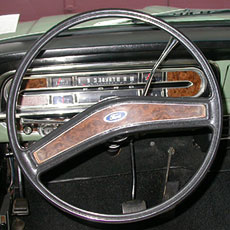
|

|
Safety Reflectors and Tail-light Bezels |

1967
No reflectors |

1968
Side reflector, no
rear reflector |

1969
Both side and
rear reflectors |

1970-1972
Rear reflector and lighted
side marker light |
Stricter new 1968 Federal safety regulations required use of reflectors at
the rear of the truck. The 1967 models did not have
any, while 1968 had side reflectors but none below the tail-light and 1969 versions
 (pictured above center) had them below
the tail-lights and along the sides. For the 1970-1972 models, the rear reflector
was reshaped as well as the side reflector, which was moved up into the side-panel ridge
and illuminated from behind (above right). The bed/s quarter panel
extensions on '70-'72 bed
were redesigned to accommodate this lighted reflector. The ridge was 'cut
down' about halfway and included a hole for mounting the light assembly.
(pictured at right, click to enlarge) (pictured above center) had them below
the tail-lights and along the sides. For the 1970-1972 models, the rear reflector
was reshaped as well as the side reflector, which was moved up into the side-panel ridge
and illuminated from behind (above right). The bed/s quarter panel
extensions on '70-'72 bed
were redesigned to accommodate this lighted reflector. The ridge was 'cut
down' about halfway and included a hole for mounting the light assembly.
(pictured at right, click to enlarge)
The chrome bezels around the tail-lights were optional for all
'67-'72 trucks.
Ford made two styles of tail-light bezels: The two-screw mount which fit
models without tailgate
moldings (see 1969 picture above) and the three-screw mount which fit models
with tailgate moldings such
as the Ranger and custom cab (pictured above in '67 and '68). (The '73-'79 bezels
look similar but are larger than either '67-'72 style.)
 |

'68 & '69
Camper Specials and F350's had front marker lights made by Dietz. They ran
off a separate circuit with a relay and circuit breaker mounted on the
passenger side. This circuit also powered the clearance lights on the roof
and the marker lights on the stake & platform trucks.
'70-later got
the wraparound turn signal lights in the front which made the front marker
lights redundant. |
DID YOU
KNOW:
 In '67 all cars (except Chrysler products) had to have front marker
lights and rear reflectors. In '67 all cars (except Chrysler products) had to have front marker
lights and rear reflectors.
 In '68 all cars (except Chrysler products) had to have front and rear
lights; trucks had to have front reflectors, hence the revised hood
emblems on the Ford trucks to include a built-in reflector. In '68 all cars (except Chrysler products) had to have front and rear
lights; trucks had to have front reflectors, hence the revised hood
emblems on the Ford trucks to include a built-in reflector.
 In '69 all cars had to have full-time parking and side lights; trucks
had to have front/rear reflectors. In '69 all cars had to have full-time parking and side lights; trucks
had to have front/rear reflectors.
 In '70 trucks had to have full-time parking and side marker lights. In '70 trucks had to have full-time parking and side marker lights.
The '70-up
pickups have parking lights that wrap around the side which were
considered acceptable as side lights too, as long as they stayed on with
the headlights. A wiring change in '70 made the parking lights stay on
with the headlights, unlike the '67-'69 trucks which had parking lights
that were off whenever the headlights were on. (The '70 change was in
the wiring harness, not in the headlight switch, which remained the same
from the previous year.) |

|
Fuel tanks |
|
 |
|
The fuel tank mounting on '67-'69 cabs is different than '70-'72. On
the early cabs, the tank is bolted in from the inside. The interior
cab support has three holes with J-nuts and the tank bolts into
these. On the later cabs, the five reinforcing ribs on the exterior
have an additional small angled rib drilled to accept a small
carriage bolt, which extends into the cab support in the interior
and is held in place with a small clip. The tank is then installed
and tightened down with a nut. (You can see the heads of the
carriage bolts in the green cab above.) Because of the 3-bolt design
of the early tanks vs. the 5-bolt design of the later tanks, they
are not interchangeable without drilling the tank lip. The later
tank also is bolted in at the bottom flange, whereas the early tank
simply sits in a pair of grooved plates secured by the rear cab
mounting bolts. As a side note, all '67-'69 tanks are painted body
color, while '70-'72 tanks are painted black. |
|
|
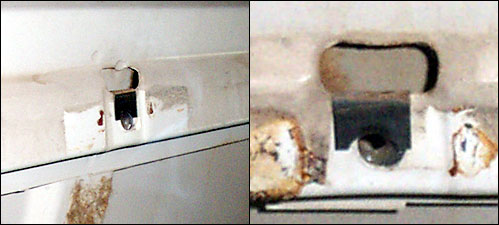
Early-style fuel tank attachment, inside the cab ('67 F100)
|
|

Early-style tank installed
|

1967-1969
fuel tank - 3-bolt top flange
(Note
the differences in the lower tank flange between these two tanks.)

1970-1972
fuel tank - 5-bolt top flange
|
|

Late-style fuel tank attachment, inside the cab ('70 F100)
|

Another
thing to consider is that when the fuel tanks changed in '70, a larger
fuel line size was used, which of course means a larger fuel tank
fitting. If you ever need to replace your in-cab tank line, be sure to
get a line from the correct year of tank...'67-'69 or '70-'72. The
'67-'69 tank uses a 5/16" line with a 1/2"-20 flare nut, whereas the
'70-'72 tank uses a 3/8" line with a 5/8"-18 flare nut.
(Click
thumbnail to enlarge)
|
|
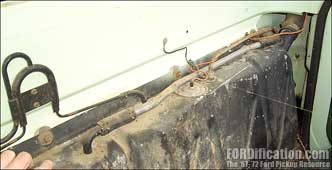 Some '70-'72 trucks had fuel tanks with emission control
plumbing. The extra lines went up to a charcoal canister located on the
front right-side frame rail. Another hose extended from the charcoal
canister up to the air filter housing. This allowed the engine to burn
fuel tank vapors. Some '70-'72 trucks had fuel tanks with emission control
plumbing. The extra lines went up to a charcoal canister located on the
front right-side frame rail. Another hose extended from the charcoal
canister up to the air filter housing. This allowed the engine to burn
fuel tank vapors.
This style of tank used a
non-vented gas cap, since the charcoal canister was the vent. Since the
'67-'69 trucks had no charcoal canister, they utilized a vented gas cap.
The '67-'69 caps are not
interchangeable with the '70-'72 versions, since the fuel filler
neck is specific to the vented or non-vented caps. This was by design,
to prevent someone from putting a non-vented cap on an early tank which
needed a vented cap.
(Click
thumbnail to enlarge)
|

|
Hood letters: '67-'69
vs.'70-'72 |
|

|
There are two different styles of chrome hood letters. The 1967- 1969
style is smaller and has small ribs which run horizontally through each
letter. The later style doesn't have the ribs and has a satin-like
finish inside each letter. The '67-'69 style is pressed onto clips in
the hood, whereas the '70-'72 style is held onto the hood with nuts from
the backside.
In this photo, the '67-'69 style is on bottom and the '70-'72 version is
shown on top. Because of the difference in size and mounting pin
location, they are not interchangeable.
|

|
Miscellaneous notes |
|
 Headliner trim: '67-'69 are 6-piece (white and chrome) and
'70-'72 (white and chrome) are 4 piece. The early trim has separate rear
corner pieces (accounting for the extra 2 pieces) whereas the newer trim
has the rear corner brackets as a integral part of the side pieces.
The trim sets are interchangeable for all years. Whatever's in a cab now
would seem to be dependent on what the restorer/owner had in good
condition on hand at the time.
Headliner trim: '67-'69 are 6-piece (white and chrome) and
'70-'72 (white and chrome) are 4 piece. The early trim has separate rear
corner pieces (accounting for the extra 2 pieces) whereas the newer trim
has the rear corner brackets as a integral part of the side pieces.
The trim sets are interchangeable for all years. Whatever's in a cab now
would seem to be dependent on what the restorer/owner had in good
condition on hand at the time.
 Sunvisors and mirrors: '67-'69 pickups have
narrow mirrors. The '67 mirror bracket screwed into the windshield frame
and incorporated the sunvisor's park slot. '68-later mirrors were glued
to the windshield and had the park slot as a separate plastic piece
screwed into the windshield frame. The sunvisors for '67-'69 had narrow
cutouts to clear the narrow mirrors, but starting in '70 when Ford
widened the mirrors by several inches, the sunvisor cutouts had to be
widened.
Sunvisors and mirrors: '67-'69 pickups have
narrow mirrors. The '67 mirror bracket screwed into the windshield frame
and incorporated the sunvisor's park slot. '68-later mirrors were glued
to the windshield and had the park slot as a separate plastic piece
screwed into the windshield frame. The sunvisors for '67-'69 had narrow
cutouts to clear the narrow mirrors, but starting in '70 when Ford
widened the mirrors by several inches, the sunvisor cutouts had to be
widened.
So...to
recap, there were three different style of mirrors and two different
sunvisor styles:
MIRRORS: the '67-only mirror/visor bracket, the '68-'69 narrow
glue-on mirror and the '70-'72 wide glue-on mirror.
VISORS: the '67-'69 narrow-notch and the '70-'72 wide-notch
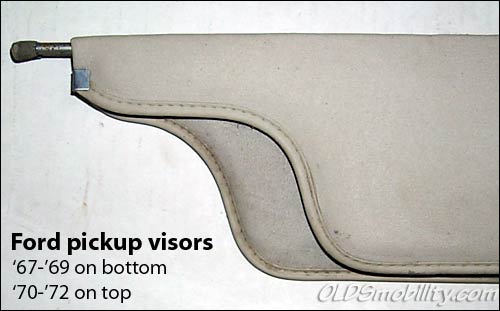 |
|
Also, on the
'70-'72 visor, the peg which parks into the bracket above the rear view
mirror has a notch to hold the rubber tip, and the tip itself has a ridge
inside to hold it on. The '67-'69 visors don't have these features. The later-style visors with this grooved tip
can either be pointed (like pictured at right) or straight cut. |
 |
|
Here's a
comparison shot of the two different sizes of mirrors, each with
it's matching sunvisor. The top visor and mirror in this picture is
the '70-'72 wide style. The '67-'69 had the narrow mirror style as
shown on bottom. The mirror in this picture is the '67-only
windshield frame style mount, whereas the '68-'69 trucks had a
glue-on mount, similar to the '70-'72 style.
(Click
to enlarge) |
 |

|
1967 vs. 1968-1972 |
|
Even though there were no major body-style changes for Ford's F-series pickups
during the '67-'72 range, the 1967 pickup has many anomalies that aren't found
on it's younger brethren. Therefore it's much easier to pick out an original
version. Some of these differences are listed here, but for a more-complete
tutorial, visit 1967 Ford Trucks Model Year
Differences.
|
|
Hood Side Emblems |
|
The 1967 hood emblem (top) had to be redesigned for the 1968 (and
subsequent) model years (bottom), due to the previously-mentioned Federal
safety regulations requiring the reflectors on the front of the vehicle as
well as the rear. The hood trim for other F-series models (F-250, etc. )
had similar changes. The mounting pins are in similar locations, so the
two styles
are interchangeable. |

1967

1968-1972
|

|
Doors and door panels |
|
1967 Ford pickup doors (pictured above
right) have the lever-style door release and no push-button provision for
locking the door. To lock this door, you would push down on the release
handle on the driver's side or pull up on the passenger-side handle.
The '68-'72 style (pictured below right) had
a squeeze-type release and the door lock button.
Obviously, due to the differences in door
opening and locking hardware, the door panels do not interchange, although
the doors will interchange as a unit. The glass, hinges, window crank
assemblies
and vent window assemblies interchange, although the '67 vent window had a
different style of vent latch handle: |

1967

1968-up |
|
 |
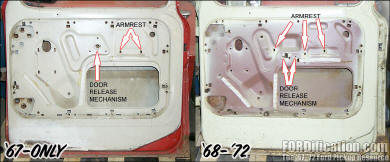 |
Here is a
comparison of the inner doors behind the door panels. You can see that the
'67 door release mechanisms cannot be swapped with the '68-'72 versions
without some major surgery. |

The '67 pickup heater controls (pictured
above right) were the pull-cable style.
New 1968 safety regulations required a
redesign of the controls for the '68 and later models (pictured middle
right).
'68-up trucks equipped with the true
factory-installed air-conditioning/heater assembly had the slider
controls to operate both (lower right).
|
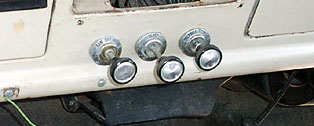
1967 |
|

1968-up |
|

1968-up
|

|
Ashtrays |
|
There are three different ashtray styles used in the
'67-'72 trucks. The C7 ashtray is unique one-year-only item, will not
fit later trucks The ashtray receiver from a '67 pickup is attached to
the dash with one center-mounted screw on top and two side screws (one
screw along each side).
The '68-'72 ashtray receiver is held on by 2 screws each on
top and bottom and has a ball-bearing track on each side. The handles of
each are also slightly different. The '67 ashtrays are not
interchangeable with the '68-'72 versions.
The D1 ('71-'72) ashtray is an improved design over the C8
('68-'70) ashtray. The ball bearings are held captive so you don't lose
them and is the replacement for the '68-'70 ashtrays. Pictured here is
the '67 style (left) and the '71-'72 (right). |


CLICK TO ENLARGE |

|
Radios |
|
1967 AM radios were about as basic as you could get. They were
smaller than the '68-'72 versions and thus the opening in the dash was smaller. A '68-up radio
will not fit a '67 without dash modification.
CLICK HERE for '67-only radio
dimensions. |

1967
|
|

|
|
1968-1972 AM radios included pushbuttons for station selection,
although a manual AM radio without the push buttons was available
(below).
|

1968-1972
|
|
 |
|

|
|

AM-FM radios were available in
the 1971 and 1972 models and included door-mounted stereo speakers. |
|

1967-only radio delete plate
If you specified the radio delete option, you'd get
this
nifty plastic plate to cover the radio's dash opening. Pictured above is a '67-only
version. The version for the '68-'72 radio (below) was larger, to fit the
larger dash opening. The two styles are not interchangeable. |
|
 |
|

1968-1972 radio delete plate |
|
 |

Want to link to
this site? Please save this banner to your hard drive to place on your
webpage.
The correct link to use is
http://www.fordification.com
|